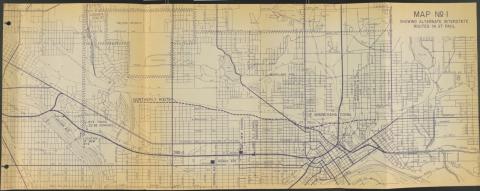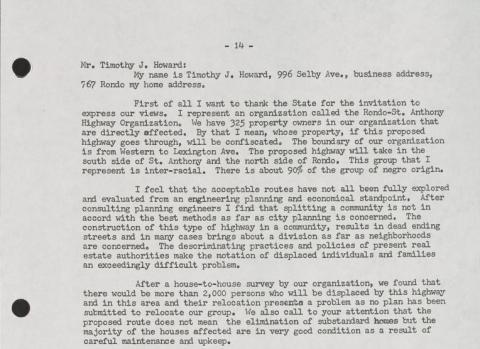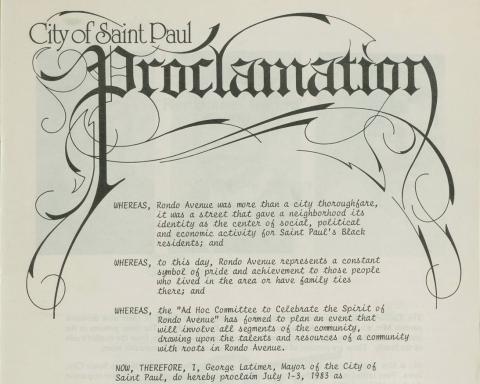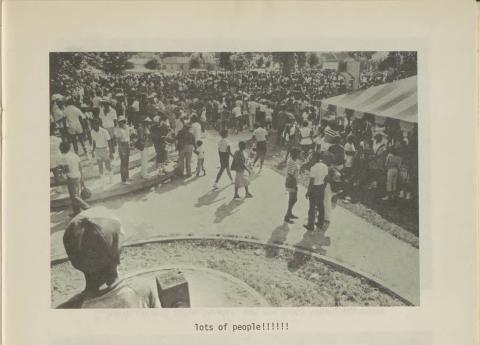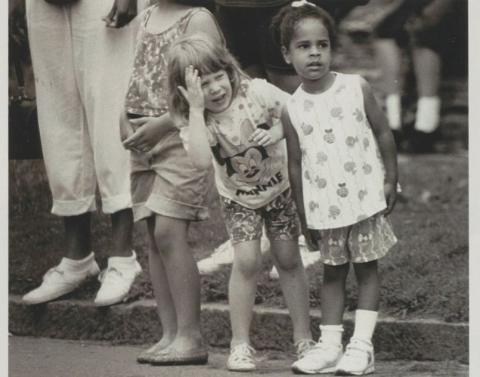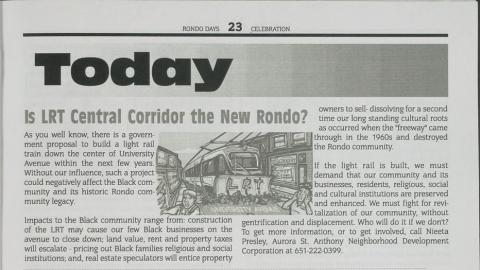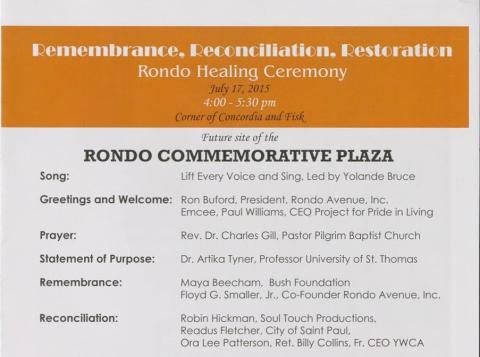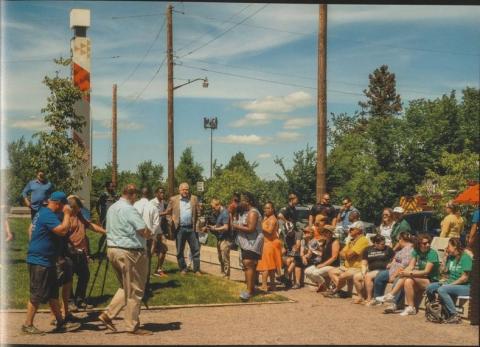Primary Source Set
by Katie Frye and Linda Cobb, Rondo Center of Diverse Expression
People of Minnesota Social Issues Transportation
See Rondo: Before the Highway for the Rondo story from its founding until the mid-nineteenth century.
In the 1930s and 40s, St. Paul city residents and officials called for a highway linking the city centers of St. Paul and Minneapolis. Though a route running alongside railroad lines was proposed (the Northern Route), the city ultimately decided to route the highway along St. Anthony Avenue (the St. Anthony Route), right through the Rondo neighborhood. The Federal Highway Act of 1956 provided the necessary funding to construct the highway.
Resistance from the Rondo neighborhood came quickly. Reverend Floyd Massey Jr., Timothy Howard, and the Rondo-St. Anthony Improvement Association protested the proposed route. Their efforts led to I-94 being built below ground level, so that environmental effects could be minimized and bridges could unite the two halves of the Rondo neighborhood. Still, the construction of the Interstate led to the loss of seven hundred homes and three hundred businesses. One in every eight African Americans in St. Paul lost a home to I-94, and many businesses never recovered. Plus, the undervaluation of people’s homes left them without deserved compensation.
For instance, the Anderson family had owned “Rangh Court,” a row of sturdy townhomes along Rondo Avenue. Appraisers from the Minnesota Department of Transportation (MnDOT) identified the townhomes as “inferiorly constructed” and undervalued their worth. Under eminent domain laws, Rangh Court was condemned and vacated, and the Andersons were under-compensated for its value. Later, the townhomes were sold to private contractors and re-located in St. Paul. They still stand today. Like many Rondolites, the Anderson family fought through the legal system without success. Other displaced residents took the lowball offer and moved away; still, others sat, armed, on their front porches and waited for the police to evict them.
The area where Rondo once thrived is now known as the Summit-University neighborhood. Past residents continue to commemorate the people, places, and memories of Rondo through community organizations and city initiatives. The Rondo Commemorative Plaza (RCP) tells the history of Rondo across 20 exhibit panels, the Rondo Community Land Trust promotes community economic development and housing affordability, Rondo Avenue Inc. manages the annual Rondo Days festival & parade, and ReConnect Rondo envisions a land bridge capping I-94. Events such as Rondo Days, Juneteenth, and the Rondo Block Party are celebrated annually. Rondo’s legacy continues to live on, through memory, celebration, and efforts to reunite the neighborhood
Discussion Questions & Activities
- Look at the map showing the proposed Northern Route of I-94 from the Minnesota Department of Transportation. Make sure you read what the dots represent on the upper-right hand corner of the map! Based on this information, how might the St. Paul Highway Commission have justified their decision to route the highway through the Rondo neighborhood instead of using the “Northern Route”?
- Read through the testimonies from Timothy Howard and Floyd Massey at the public hearing for the routing of I-94 in 1956. What concerns do Mr. Howard and Mr. Massey raise about the routing of the highway? Compare and contrast the arguments and their tones. How do their arguments differ? Is one more convincing to you?
- See the picture of the boy looking out at the freeway construction. What feelings are present in this photograph? Write a creative narrative from his perspective.
- Read the paragraphs about eminent domain in eLibraryMN's Gale Encyclopedia. What is eminent domain? Do you think eminent domain laws were applied fairly to Rondo residents?
- Look at the comic within the article entitled, “LRT Central Corridor the New Rondo?,” in the 2007 Rondo Days Celebration booklet. What statement is the artist trying to make? How does the author of the article compare the construction of the Green Line Light Rail to the destruction of the Rondo neighborhood?
- Page through the photos of Rondo Days in “Looking Back from Where We Came” compiled in 2008. What feelings do the images evoke?
- Page through the Agenda of the Rondo Healing Ceremony. During the ceremony, the Mayor of Saint Paul, Chris Coleman, stated, “Today, as Mayor of Saint Paul, I apologize, on behalf of the city, to all who call Rondo home, for the acts and decisions that destroyed this once vibrant community.” Based on the agenda and apology, what steps do you think are necessary for reconciliation and community healing?
- Think about the residents who lost homes and businesses in the Rondo community. What happened to the wealth they held? How did the displacement of homes and businesses affect intergenerational wealth-building? Can you think of other ways Rondo’s history continues to affect our current reality?
- Reflect on the Rondo story. Have you heard of other communities being affected by displacement? How are their experiences similar and different to Rondo?
eLibrary Minnesota Resources (for Minnesota residents)
"African Americans." International Encyclopedia of the Social Sciences, edited by William A. Darity, Jr., 2nd ed., vol. 1, Macmillan Reference USA, 2008, pp. 34-37. Gale In Context: High School. Accessed 12 July 2024.
Baker, Keith, and Glenn Isaac Smith. "After highways split Black communities, we're reconnecting." USA Today, 26 Feb. 2024, p. 07A. Gale In Context: High School. Accessed 12 July 2024.
"Eminent Domain." Gale Encyclopedia of Everyday Law, edited by Donna Batten, 3rd ed., vol. 2:
Health Care to Travel, Gale, 2013, pp. 1233-1236. Gale In Context: High School. Accessed 1 Nov. 2024.
Fox, Jeremy C. "Urban Renewal." Human Geography: People and the Environment, edited by K. Lee Lerner, et al., vol. 2, Gale, 2013, pp. 653-656. Gale In Context: High School. Accessed 12 July 2024.
Jacobson, Louis, and PolitiFact. "Roads Paved by Racism: Pete Buttigieg's Statement About the History of Highway Planning and its Devastating Effect on Underrepresented Communities Does Stand Up." Tampa Bay Times, 2021 Apr 23, 2021/04/23, pp. 20. ProQuest. Accessed 12 July 2024.
"Minnesota housing program aims to mend years of economic damage in black neighborhood."
All Things Considered, 22 Sept. 2023, p. NA. Gale In Context: High School. Accessed 1 Nov. 2024.
Additional Resources for Research
Alam, Ehsan. “Before it was cut in half by I-94, St. Paul’s Rondo was a thriving African-American cultural center.” MinnPost, 19 June 2017. Accessed 12 July 2024.
Briggs, Jimmie. "Before the Highway: Saint Paul, Minnesota." AARP, 1 February 2023. Accessed 4 November 2024.
Burnside, Tina. “African Americans in Minnesota.” MNopedia, 26 July 2017. Accessed 6 July 2024.
Davitt-Liu, Indigo, & Landi, Jacy. Rooted in Rondo. Sounds Powerful Productions, 2022.
Douglas, Leeta M. “Votes for Everywoman: Nellie Griswold Francis, the Women of Rondo, and Their Suffrage Crusade.” Ramsey County History, vol. 55, no. 2, 2020, pp. 1-11. Ramsey County History, Accessed 7 July 2024.
Fairbanks, Evelyn. The Days of Rondo. Minnesota Historical Society Press, 1990.
Hand in Hand Productions. “Rondo Oral History Project.” Hand in Hand Productions. Accessed 7 July 2024.
Kennon, Marion Jones. "“We Learn What We Live and Live What We Learn:” Growing Up at 1022 Rondo Avenue.” Ramsey County History, vol. 56, no. 4, 2022, pp. 13-20. Ramsey County History. Accessed 7 July 2024.
PBS. “Interstate 94: A History and Its Impact.” PBS, 1 April 2017, Accessed 12 July 2024.
Presley, Nieeta L. “Traveling Without Aggravation: How Victor H. Green Changed Travel for Black Americans: Green Book Locations in the Historic Rondo Community (1940-1956).” Ramsey County History, vol. 57, no. 2, 2022, pp. 1-13. Accessed 7 July 2024.
Rabb, Jonathan, & Williams, Brandt. Untangled Roots. MPR, 2022.
Rhodes, Bianca & Fort, Georgia. Rondo: Beyond the Pavement. Sounds Powerful Productions, 2018-2019.
Rondo Oral History Project. Voices of Rondo: Oral Histories of Saint Paul's Historic Black Community. University of Minnesota Press, 2017.
Sebesta, Susanne, and Jennifer Kleinjung. “Overview - Rondo Neighborhood & I-94.” LibGuides at Minnesota Historical Society Library, 20 December 2023. Accessed 12 July 2024.
White, Frank M. “Remembering One of Our Community Legends – Jimmy Lee.” Ramsey County History, vol. 53, no. 4, 2019, pp. 1-10. Ramsey County History. Accessed 7 July 2024.
Published onLast Updated on
